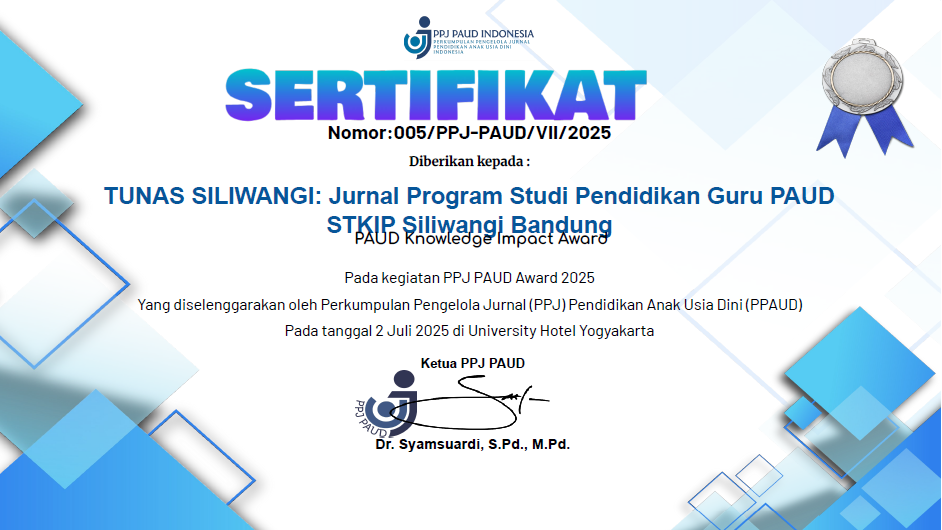The relationship of gadget use to social behavior of children
DOI:
https://doi.org/10.22460/ts.v10i2.5011Keywords:
Early childhood, gadgets, social behaviorAbstract
The problem stems from the increasing prevalence of gadgets in children's daily lives, which has raised concerns about their potential impact on their social development. As gadgets become more integrated into the family environment, there is a need to explore whether their use may negatively affect children's ability to interact and develop socially. To achieve this goal, the study adopts a quantitative approach and uses cluster random sampling to select 150 parents whose children are enrolled in five kindergartens (TK) in Natar District. These children are between five and six years old, which is a critical period in their social development. Data collection in this research will be done through a structured questionnaire distributed to the parents. This questionnaire is designed to capture both the frequency of gadget use and various aspects of children's social behavior. The study uses Pearson Product Moment Correlation Analysis to examine the relationship between these two variables. In terms of data analysis, the results show a statistically significant relationship between gadget use and social behavior. With a Pearson correlation coefficient of -0.930 and a significance level (sig. 2-tailed) of 0.000 (which is less than the 0.05 threshold), the results indicate a strong, negative correlation. This suggests that higher levels of gadget use are associated with poorer social behavior in children. In conclusion, the study provides evidence that gadget use in young children has a significant impact on social behavior.
References
Anggiarini, D. F. (2016). The Relationship Between Students’ Enrollment In English Courses and Students’ English Achievement.
Bartosiewicz, A., Łuszczki, E., Kuchciak, M., Bobula, G., Oleksy, Ł., Stolarczyk, A., & Dereń, K. (2020). Children’s Body Mass Index Depending On Dietary Patterns, The Use Of Technological Devices, The Internet And Sleep On Bmi In Children. International Journal of Environmental Research and Public Health, 17(20), 1–17. https://doi.org/10.3390/ijerph17207492
Colborne, G. (2022). Simple and Usable Web, Mobile, and Interaction Design (Vol. 16, Issue 1).
Dewi, E. M. P., Damayanti, E., Halimah, A., & Jalal, N. M. (2021). The Description of Parents’ Psychological Conditions in Accompanying Children To Learn During the Implementation of Study From Home (Sfh) in Makassar City and Gowa Regency. Lentera Pendidikan : Jurnal Ilmu Tarbiyah Dan Keguruan, 24(1), 144. https://doi.org/10.24252/lp.2021v24n1i14.
Egan, S. M., & Pope, J. (2022). A Bioecological Systems Approach to Understanding the Impact of the COVID-19 Pandemic: Implications for the Education and Care of Young Children. Educating the Young Child, 18(November 2021), 15–31. https://doi.org/10.1007/978-3-030-96977-6_2
Erna, M. N., Kurniawati, Y., Pranoto, S., & Nuzulia, S. (2023). The Influence of Children’s Gadget Use Intensity on Their Social Skills. JPUD - Jurnal Pendidikan Usia Dini, 17(2), 407–424. https://doi.org/10.21009/jpud.172.15
Fatmawati, F. A. (2023). The Impact of Gadget Use on Early Childhood in Suci Village, Manyar Sub-district. EDUTEC : Journal of Education And Technology, 6(4). https://doi.org/10.29062/edu.v6i4.692
Griffiths, M. D., & Kuss, D. J. (2017). Adolescent Social Media Addiction (Revisited). Education and Health, 35(3), 49–52.
Joshi, A., Kale, S., Chandel, S., & Pal, D. (2015). Likert Scale: Explored and Explained. British Journal of Applied Science & Technology, 7(4), 396–403. https://doi.org/10.9734/bjast/2015/14975
Ludwig, R. J., & Welch, M. G. (2022). Wired to Connect: The Autonomic Socioemotional Reflex Arc. Frontiers in Psychology, 13(June). https://doi.org/10.3389/fpsyg.2022.841207
Munawar, M., & Nisfah, N. L. (2020). The Effect of Assertive Discipline on Early-Aged Children’s Gadget Addiction. Journal of Early Childhood Care and Education, 2(2), 64. https://doi.org/10.26555/jecce.v2i2.1002
Ningrum, E. A., Roza, N., & Natalia, R. (2024). The Relationship of Gadget Use to Social Interaction and Learning Achievement Levels in Sagulung Elementary School Students in Batam City 2023. International Conference of Health Institut Kesehatan Mitra Bunda 2024, 2024, 101–108.
Nirwana, Chairunnisa, & Mappapoleonro, A. M. (2018). The Effect of Gadget Toward Early Childhood Speaking Ability. Indonesian Journal of Early Childhood Education Studies, 7(2), 85–90.
Nudin, B., Lukman, Sihab, W., Aldinata, N., Imaduddin, M. D., & Triono. (2024). The Role of Parents and Families in Children’s Education in the Digital Era. Linguanusa: Social Humanities, Education and Linguistic, 2(1), 9–22.
Oktaria, R., & Putra, P. (2020). Pendidikan Anak Dalam Keluarga Sebagai Strategi Pendidikan Anak Usia Dini Saat Pandemi Covid-19. Jurnal Ilmiah Pesona PAUD, 7(1), 41. https://doi.org/10.24036/108806
Putra, R. A., Ashadi, A., & Aziz, M. F. (2022). Excessive Gadget Exposure and Children Speech Delay: The Case of Autism Spectrum Risk Factor. Script Journal: Journal of Linguistics and English Teaching, 7(01), 176–195. https://doi.org/10.24903/sj.v7i01.1077
Putri, D. P. (2022). Pentingnya Pendidikan Karakter pada anak Sekolah Dasar di Era Digital. Jurnal Pendidikan, Bahasa Dan Budaya, 1(1), 83–88. https://doi.org/10.55606/jpbb.v1i1.836
Rahayu, D., Nanda, A. T., Putri, H. A., & Rizqfino, F. R. (2022). Mother Involvement as An Effort to Prevent Internet Addiction in Children. Jurnal Aisyah : Jurnal Ilmu Kesehatan, 7(4), 1239–1246. https://doi.org/10.30604/jika.v7i4.1389
Riyanasar, Wardhani, J. D., & Supriyono, H. (2023). Gadgets and Their Impact on The Development of Religious and Moral Values. International Journal of Active Learning, 8(1), 1–9.
Santrock, J. W. (2011). Educational psychology. McGraw-Hill.
Sugiyono. (2013). Metode Penelitian Pendidikan (Pendekatan Kuantitatif, Kualitatif dan R&D). Alfabeta.
Suherman, R. N., Saidah, Q., Nurhayati, C., Susanto, T., & Huda, N. (2021). The Relationship Between Parenting Style and Gadget Addiction Among Preschoolers. Malaysian Journal of Medicine and Health Sciences, 17(June), 117–122.
Surandika, W., Suriansyah, A., & Wahdini, E. (2023). Learning Alignment of School Readiness in One-Year Early Childhood Education Student to first grade of Elementary School. International Journal of Social Science And Human Research, 06(01), 414–425. https://doi.org/10.47191/ijsshr/v6-i1-55
Third, A., Bellerose, D., Diniz, J., Oliveira, D., Lala, G., & Theakstone, G. (2017). The State of the World’s Children 2017 Companion Report. Western Sydney University, December. https://www.westernsydney.edu.au/__data/assets/pdf_file/0006/1334805/Young_and_Online_Report.pdf
Utami, R. budi, Nadiyatul, U. S., Suroso, H., Ekwantoso, & Paraswati, M. D. (2023). The Use Of Gadgets With The Psychosocisl Development Of Preschool-Age Chldren. Synthesis Original Article, 1(2), 73–79
Downloads
Published
Issue
Section
License
Copyright (c) 2025 Putri Indah Sari

This work is licensed under a Creative Commons Attribution-ShareAlike 4.0 International License.
The author is responsible for acquiring the permission(s) to reproduce any copyrighted figures, tables, data, or text that are being used in the submitted paper. Authors should note that text quotations of more than 250 words from a published or copyrighted work will require grant of permission from the original publisher to reprint. The written permission letter(s) must be submitted together with the manuscript.







